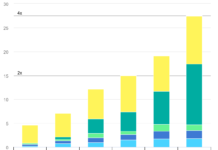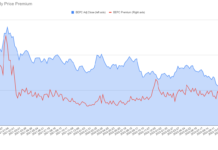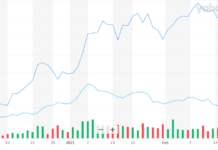by Garvin Jabusch
We now live in a global economy with two fundamentally different types of energy: commodity-based in the form of fossil fuels and uranium, and technology-based, represented primarily by solar and wind. That observation is interesting as far as it goes, but what does it mean? The term renewable (as it pertains to energy) gets used so often that it is easy to forget what it really entails. For starters, tech-based renewables become less expensive over time, as demand for them drives scale, innovation, and improves cost structures in implementation (think about the last couple of computers you’ve purchased). This is precisely the opposite of how we have traditionally thought about energy and, how it’s priced. With commodity-based energy like coal and oil, energy costs go up over time as demand increases (population and economic growth necessitates this) and the cheaper-to-acquire sources are used up. The contrast between the old and new means of acquiring energy is nothing less than revolutionary, as it means that economic growth need no longer choke itself off as a consequence of its own success. Since the fuels for technology-based energy (sunshine and wind) are free, it means we’re entering into a fundamentally new economic era wherein traditional measurement of energy costs will no longer apply.
We currently measure energy in units of power from the supply side: gallons, barrels, BTUs, kilowatt hours, and so on. However, if power generation is no longer slave to a commodity resource with its accompanying supply and pricing dynamics, perhaps it’s time to change how we measure it.
Given the amount of power the world economy uses in a day, compared to the available wind and solar power naturally provided in a day, the potential power that can be harnessed is basically infinite for human purposes. To illustrate this, imagine the time in history when everyone thought there was infinite coal and oil in the ground, but we just didn’t have very many wells or mines to get it out. This was, as far as anyone then could see, the situation at the dawn of the 20th century, when oil rushes and coal booms around the globe redrew borders, sparked decades-long wars, and reshaped human existence on the planet. The future of human productivity was at stake, and people rushed to capitalize on that, similar to how investments are beginning to flow today towards the great transition of our own time – the switch to electrification through renewables.
Of course, there are some crucial differences between the renewable energy future we see today and the beginning of the fossil fuel era that shaped the last century. For one thing, oil and coal turned out to be nowhere near infinite: in fact, the more we use, the more we need, and the harder (read: more expensive) it becomes to get. A similar argument is sometimes made (poorly) about sun and wind: the best spots for wind and solar will be utilized first to maximize investment, and over time more marginal areas will have to be utilized. For instance, Hawaii and California, both very sunny places, are moving quickly on utility-scale solar. Similarly, flat and windy Texas is a world leader in installed generating capacity for wind turbines. However, unlike oil, the amount of sun that falls on less sunny places, like Vermont, is still consistent and never diminishes. The same is true for more and less windy places. To cap all of that off, the amount of wind and sun that occur even in the darkest and least windy places is still in excess, given sufficient deployment of renewables, of current power needs.
So, what happens now as the equivalent of unlimited barrels and gallons, falling from the sky for free, are increasingly captured and put to productive economic use? Will we remain fixated on measurement only from the supply side? Could we even if we wanted to? Can one put a meter on sunlight? Perhaps a more relevant measure now would be to assess the ability of that energy to do productive work, or in economic terms, to turn material into products and to provide services. Much as supply measurements are used today, this more descriptive production measure would be applied the same to, say, the energy needed by a company like Patagonia to turn plastic bottles into high quality fleece clothing, and the power to operate your television.
Essentially the question becomes: how much of the energy we pour into the economy is productive and how much is wasted? According to economists, notably John A. “Skip” Laitner, about 15% of it becomes economically useful while the remaining 85% dissipates unrequited (here is Laitner’s 2013 paper; free registration required).
Green Alpha’s Next EconomyTM thesis is that our collective and per capita economic activities must ultimately have only a de minimus impact on the economy’s underlying ecosystems, all while we maintain and improve standards of living. In that light, any accounting of global economic activity that suggests we are only getting 15% of the productive energy we generate is, to put it mildly, kind of a big deal. It means that the ability of our economy to grow and to run in a way that won’t overtop earth’s carrying capacity is badly hampered relative to what could be. “You can imagine what a huge array of costs that imposes on the economy and that set of costs just clamps down and makes it harder to provide economic activity and to provide jobs that we need,” as Laitner put it on a recent podcast.
If energy is increasingly coming from a cost-negligible source, and the lifetime of the technology we use to capture it is long enough to easily amortize its capital expenditure, it is time to start focusing on what we do with it, and how. There will, before long, be such an abundance of renewable energy available that we need to start asking how it can best be deployed to maximize economic gains. Measuring where energy goes, and what is done with it when it gets there, will become more important than where it comes from. Laitner has reached a similar conclusion: he believes that our abysmally low rate of converting energy to productive work is a systemic weakness. As he has blogged, “if we miss the big gains in energy and exergy efficiency, focusing instead on investments in costlier and more hazardous new energy resources, we run the risk of a continued weakening of the economy.” (Italics added.)
Energy efficiency and resource productivity are opposite sides of a coin. We need efficiency to do more with less: less material inputs, less person-hours, less water, etc. Doing more with less is key to providing jobs and transitioning to an indefinitely sustainable economy. As the world electrifies, economies will increasingly revolve around renewables to power the factories, shipping, computers and consumers who require those goods and services. What matters now is measuring energy’s ability to functionally provide for society, as opposed to the price per of input on the supply side. Put another way, the 85% of energy we generate and pay for that is wasted is an enormous basket of costs that slows the potential growth of the global economy in all of its manifestations (e.g. job growth).
Growth in global economic productivity is well understood to be slowing. The Organization for Economic Cooperation and Development (OECD) has recently given the global economy a “barely passing grade of B-.” The World Bank and others have agreed that global productivity growth this year may decline to 1-1.2%. McKinsey & Company ag
rees, and reports that the problem is more long-term and systemic: “unless we can dramatically improve productivity, the next half century will look very different. The rapid expansion of the past five decades will be seen as an aberration of history, and the world economy will slide back toward its relatively sluggish long-term growth rate.”
The primary reason for slow productivity gains is the inefficient use of resources, largely energy, but also water, phosphorus, land and human labor, among many others. Structurally, in terms of our institutional understanding of how to address this, the problem is that we don’t track the right kind of data to measure the effective use of energy in the economy. The conversion of energy to productivity is the numerator in the ratio of human endeavor to global economic growth. We collect energy’s supply side information, but we don’t track how much of that ends up being productive. This is odd, because that’s really the core of understanding economic activity. Moreover, the data we do have doesn’t inform us how individual inputs can help optimize the economic activity that would, in turn, drive sustainability as well as productivity. Knowing how many BTUs we’ve sold doesn’t get us very far; again, it’s not the supply so much as the effective use of energy that runs the world.
What’s required to make best use of the emerging abundance of renewable energy is a transparent flow of rich information to measure, evaluate and direct energy in a way that optimizes use and increases productivity. To get the world thinking outside of a supply-side orientation is a big change, and will require lots of new tools and education. Perhaps the emphasis on the supply-side aspect of energy has been a consequence of the historical commodity nature of the fuels themselves. Since they have been dangerous, dirty, difficult to extract and move around the globe, those responsible have expected commensurate (perhaps outsized) recompense. Increasingly however, energy harvested from renewable sources is freeing the world from those economic handcuffs; you no longer need a multi-billion dollar coal plant to power your house or drive your car. More systematic observation, automation and intelligence in our entire array of systems and devices, with real time measurement driven by machine-to-machine and Internet-of-things technologies, all optimized by algorithms, can now accelerate this revolution.
But present supply side thinking can’t inform any of this because measuring inputs isn’t the same as measuring outcomes. Fundamentally, increasing growth, jobs and standards of living are all about reducing costs of energy, material, services and capital. As with most aspects of holistic Next Economics we have to solve for multiple objectives. So, the transition away from supply-side measurement to outcomes optimization will require a paradigm shift. Understanding what we need as a society and how to line up resources in a way to achieve those outcomes is the critical issue. And incremental improvements to legacy metrics will not cut it.
At Green Alpha Advisors we strive to rethink what we’re doing in our own business of portfolio and asset management in a way that reflects the requirement of the global economic system to evolve to align our energy, material resources and capital with our economic best interests and desires for prosperity. The old, inherited paradigms that only allow us to think in terms of incremental improvements do not help us understand the functional and structural problems associated with unutilized energy, material and capital. As Greentech Media journalist Katherine Tweed recapped from a paper from Laitner, “If we want to understand how to wring more efficiency out of our energy usage, we need to redefine energy use in the first place.”
An economy-wide 15% productive energy use rate is only good news if you’re on the supply side selling all those barrels; the wasted 85% is easy money in that case. But what happens as renewables become the globe’s dominant source of energy and there are far fewer barrels to sell? Laitner’s work seems to be agnostic regarding where energy comes from, emphasizing instead the need to redefine our old ideas about how to measure its impacts and outcomes. For Green Alpha, the fact that the world is increasingly making energy from cheap tech instead of from expensive commodities means it is finally in a position to begin recapturing the lost 85% and realizing a far more sustainable, regenerative and prosperous global economy.
We can now design an economy where a far greater fraction of our energy is put to productive use improving standards of living, accelerating progress and reducing impact on climate and resources. But before we can do that we have to reimagine how we think about energy in the first place. No one can sell a photon, so perhaps it’s time to stop running the world of energy from the supply side, using supply side metrics and talking to each other with outdated language.
Garvin Jabusch is cofounder and chief investment officer of Green Alpha®Advisors, LLC. He is co-manager of the Shelton Green Alpha Fund (NEXTX), of the Green Alpha Next Economy Index, of the Sierra Club Green Alpha Portfolio, and of the Green Alpha Global Equity Income Portfolio. He also authors the Sierra Club’s economics blog, “Green Alpha’s Next Economy.”
This material is for informational purposes only and is not an offer to sell or the solicitation of any offer to buy any security. Performance data quoted represent past performance, which does not guarantee future results. All returns are total returns net of fees.
To obtain a prospectus for the Shelton Green Alpha Fund (NEXTX), visit www.sheltoncap.com or call (800) 955-9988. A prospectus should be read carefully before investing. Shelton Funds are distributed by RFS Partners, a member of FINRA and affiliate of Shelton Capital Management.
Green Alpha is a registered trademark of Green Alpha Advisors, LLC. SIERRA CLUB is a registered trademark of the Sierra Club.









Nuclear power shouldn’t be categorized as a “commodity”. It’s as much of a technology as wind or solar. The cost of the full fuel cycle is approximately 15% of the levelized cost of electricity from nuclear power plants. And I’m not sure what to make of your describing of wind and solar (+storage?) as “free” on one hand and then emphasizing efficiency and resource and energy productivity on another…
In fact, shale gas is also a technology-driven energy resource – horizontal drilling, hydraulic fracturing, imaging and remote sensing. Technologies other than renewables will also drive a fundamentally new era of energy. Resource and environmental limitations may not be as binding or constraining as traditionally thought.